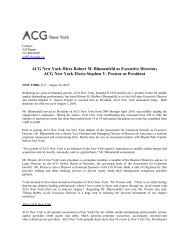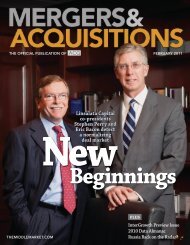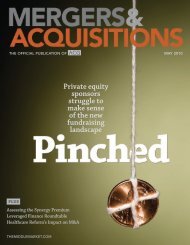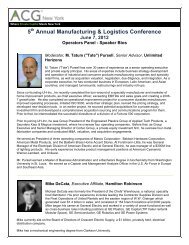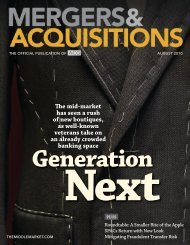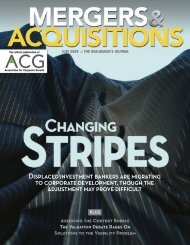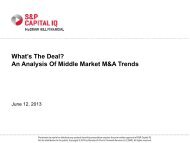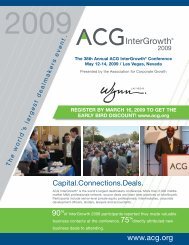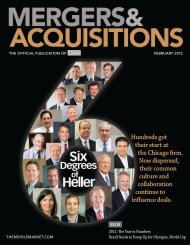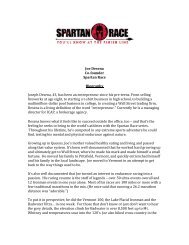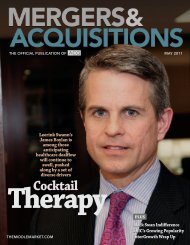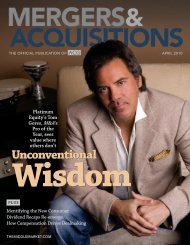Not one to mince words, KPS Capital's Michael Psaros offers a ...
Not one to mince words, KPS Capital's Michael Psaros offers a ...
Not one to mince words, KPS Capital's Michael Psaros offers a ...
- No tags were found...
You also want an ePaper? Increase the reach of your titles
YUMPU automatically turns print PDFs into web optimized ePapers that Google loves.
20-35_Roundup.qxd 4/6/09 5:39 PM Page 22Round UpDoes the M&A Space Have aMadoff in its Midst?With capital drying up, it is only a matter of time beforefraud starts showing up in the merger marketKen MacFadyen“In good timespeople steal;in bad timespeople reallysteal.”As the desiccation of liquidity exposes businessesand financial firms, instances of fraud, both ona grand scale and relatively minor offenses, seem<strong>to</strong> be emerging on a daily basis. Bernard Madoff’s ponzischeme is obviously the most talked about transgressionin recent months, though similar cases involving lawyerMarc Dreier, venture capitalist William “Boots” Del Biaggio,and Illinois Governor Rod Blagojevich has giventhe CSI set more scams than they can handle in a givennews cycle. The M&A market, while spared of anymajor hoaxes so far in 2009, is by no means immune.“In good times people steal; in bad times peoplereally steal,” Joseph Spinelli, co-founder and chiefoperating officer at Daylight Forensic & Advisory, tellsMergers & Acquisitions.Yogesh Bahl, a partner at Deloitte Financial AdvisoryServices LLP, notes that financial duress serves <strong>to</strong>“ferret out fraud,” as most schemes require a continuinginflux of cash. “As soon as the funding s<strong>to</strong>ps, that’s whenpeople start asking questions,” he says.At the same time, Bahl notes that downturns canoften present “a more fertile landscape” for fraud or collusion,as incentive schemes aren’t readjusted <strong>to</strong> dealwith the new environment. At the same time, companiesare cutting back on the infrastructure and compliancedesigned <strong>to</strong> root out fraud and employees will assumenew responsibilities that make collusion easier.In M&A, fraud can take on a number of forms. Perhapsmost common is the instance in which a targetcompany has manipulated the books and views a saleas an easy out. Marketwatchers will likely remember itwas The Blackst<strong>one</strong> Group, through its due diligence,that reportedly uncovered the fraud at Parmalat. Thedisclosure ultimately led <strong>to</strong> the dairy producer’s bankruptcyfiling.Another high-profile case, again involving a privateequity firm, occurred when former Refco CEO PhillipBennett was caught hiding $430 million of bad debt. Thiscase highlights how much damage instances of fraudcan create for the ancillary players. Bennett received 16years in prison, but in the aftermath shareholders alsowent after Thomas H. Lee Partners, which acquired Refcoand profited on its IPO; Grant Thorn<strong>to</strong>n, the company’saudi<strong>to</strong>r; and a slew of investment banks, whichunderwrote and financed the company.Malfeasance in M&A is not confined <strong>to</strong> target companieseither. Deloitte’s Bahl notes, “You also see it happenfrom the acquirer’s perspective. Once these companiesstart mixing up the financials it clouds the level oftransparency that once existed.”Most recently, this cropped up at National Lampoon,whose CEO orchestrated a scheme providingkickbacks for s<strong>to</strong>ck purchases. The aim, which fell flat,was <strong>to</strong> artificially inflate the company’s s<strong>to</strong>ck price <strong>to</strong>improve its capital position for all-s<strong>to</strong>ck deals and potentiallypump up the company’s valuation for a sale <strong>to</strong> astrategic.In other cases of fraud, companies will use M&A<strong>to</strong> create enough noise that the din distracts regula<strong>to</strong>rsfrom seeing through <strong>to</strong> the swindle. In 1999, the Securitiesand Exchange Commission had investigated Tyco<strong>to</strong> determine whether or not the company was using itsmerger-related accounting <strong>to</strong> overstate its performance.That was three years before it was finally uncovered thatTyco’s CEO Dennis Kozlowski had looted $96 millionfrom the company. In a bigger scam, WorldComtallied an almost $80 billion overstatement, using M&Aas part of, and <strong>to</strong> camouflage, the manipulation.Because of this, it’s on the shoulders of both buyersand sellers <strong>to</strong> be aware of the potential for fraud. Prospectivered flags can be easy <strong>to</strong> spot. As the Madoff casedemonstrates, the first tip off might be performance thatis <strong>to</strong>o good <strong>to</strong> be true. “Anything that looks like ananomaly deserves further attention,” according <strong>to</strong> Bahl.Another area that warrants investigation, Bahl says,is the incentive structure. If an opening for fraud exists,there’s a chance people will look <strong>to</strong> exploit it.FRAUD continued on page 8622 MERGERS & ACQUISITIONS February 2009



